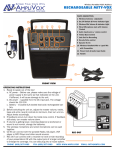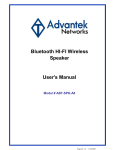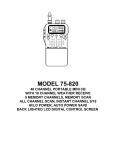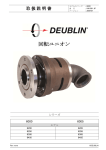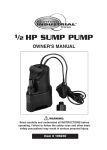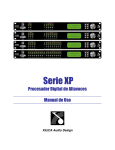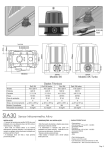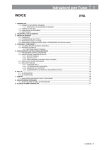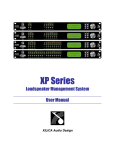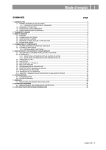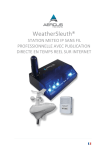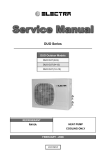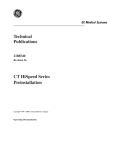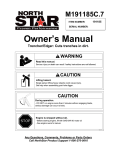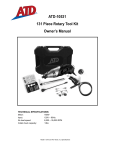Download Northern Industrial Tools 142264 User's Manual
Transcript
660-LB CAPACITY HIGH SPEED ELECTRIC HOIST OWNER’S MANUAL WARNING: Read carefully and understand all INSTRUCTIONS before operating. Failure to follow the safety rules and other basic safety precautions may result in serious personal injury. Item # 142264 Thank you very much for choosing a NORTHERN TOOL + EQUIPMENT CO., INC. Product! For future reference, please complete the owner’s record below: Model: _______________ Purchase Date: _______________ Save the receipt, warranty and these instructions. It is important that you read the entire manual to become familiar with this product before you begin using it. This machine is designed for certain applications only. Northern Tool + Equipment cannot be responsible for issues arising from modification. We strongly recommend this machine is not modified and/or used for any application other than that for which it was designed. If you have any questions relative to a particular application, DO NOT use the machine until you have first contacted Northern Tool + Equipment to determine if it can or should be performed on the product. For technical questions please call 1-800-222-5381. INTENDED USE The Electric Hoist is used to lift goods more effectively. TECHNICAL SPECIFICATIONS Description Load capacity Lifting height Lifting speed Cable length Cable diameter Resister cable Duty circle Voltage Motor performance Specification 660 lbs. 75 ft. 65 ft/min 82 ft. 7/32" (6.0mm) anti-twist >=5000 lbs. S3 50%-20 min. 220V/60Hz 2 HP GENERAL SAFETY RULES WARNING: Read and understand all instructions. Failure to follow all instructions listed below may result in electric shock, fire and/or serious injury. WARNING: The warnings, cautions, and instructions discussed in this instruction manual cannot cover all possible conditions or situations that could occur. It must be understood by the operator that common sense and caution are factors which cannot be built into this product, but must be supplied by the operator. SAVE THESE INSTRUCTIONS WORK AREA • Keep work area clean, free of clutter and well lit. Cluttered and dark work areas can cause accidents. Page 2 of 13 • Do not use your tool where there is a risk of causing a fire or an explosion; e.g. in the presence of flammable liquids, gasses, or dust. Power tools create sparks, which may ignite the dust or fumes. • Keep children and bystanders away while operating a power tool. Distractions can cause you to lose control, so visitors should remain at a safe distance from the work area. • Be aware of all power lines, electrical circuits, water pipes and other mechanical hazards in your work area, particularly those hazards below the work surface hidden from the operator’s view that may be unintentionally contacted and may cause personal harm or property damage. • Be alert of your surroundings. Using power tools in confined work areas may put you dangerously close to cutting tools and rotating parts. ELECTRICAL SAFETY • WARNING! Always check to ensure the power supply corresponds to the voltage on the rating plate. • Do not abuse the cord. Never carry a portable tool by its power cord, or yank tool or extension cords from the receptacle. Keep power and extension cords away from heat, oil, sharp edges or moving parts. Replace damaged cords immediately. Damaged cords may cause a fire and increase the risk of electric shock. • Grounded tools must be plugged into an outlet properly installed and grounded in accordance with all codes and ordinances. Never remove the grounding prong or modify the plug in any way. Do not use any adapter plugs. Check with a qualified electrician if you are in doubt as to whether the outlet is properly grounded. • Double insulated tools are equipped with a polarized plug (one blade is wider than the other). This plug will fit in a polarized outlet only one way. If the plug does not fit fully in the outlet, reverse the plug. If it still doesn’t fit, contact a qualified electrician to install a polarized outlet. Do not change the plug in any way. • Avoid body contact with grounded surfaces such as pipes, radiators, ranges, and refrigerators. There is an increase risk of electric shock if your body is grounded. • When operating a power tool outside, use an outdoor extension cord marked “W-A” or “W.” These cords are rated for outdoor use and reduce the risk of electric shock. • Extension Cord Use. A. Use only ‘Listed’ extension cords. If used outdoors, they must be marked “For Outdoor Use.” Those cords having 3-prong grounding type plugs and mating receptacles are to be used with grounded tools. B. Replace damaged or worn cords immediately. C. Check the name plate rating of your tool. Use of improper size or gauge of extension cord may cause unsafe or inefficient operation of your tool. Be sure your extension cord is rated to allow sufficient current flow to the motor. For the proper wire gauge for your tool, see chart. CHART FOR MINIMUM WIRE SIZE OF EXTENSION CORD: Nameplate AMPS 0-6 6-10 10-12 12-16 CORD LENGTH 25' 18 AWG 18 AWG 16 AWG 14 AWG 50' 16 AWG 16 AWG 16 AWG 12 AWG 100' 150' 16 AWG 14 AWG 14 AWG 12 AWG 14 AWG 12 AWG (NOT RECOMMENDED) If in doubt, use larger cord. Be sure to check voltage requirements of the tool to your incoming power source. Page 3 of 13 • Do not expose power tools to rain or wet conditions. Water entering a power tool will increase the risk of electric shock. • Do not let your fingers touch the terminals of plug when installing to or removing from the outlet. • Ground fault circuit interrupters. If work area is not equipped with a permanently installed Ground Fault Circuit Interrupter outlet (GFCI), use a plug-in GFCI between power tool or extension cord and power receptacle. PERSONAL SAFETY • Stay alert, watch what you are doing and use common sense when operating a power tool. Do not use a power tool while you are tired or under the influence of drugs, alcohol or medication. A moment of inattention while operating power tools may result in serious personal injury. • Dress properly. Do not wear loose clothing, dangling objects, or jewelry. Keep your hair, clothing and gloves away from moving parts. Loose clothes, jewelry or long hair can be caught in moving parts. Air vents often cover moving parts and should be avoided. • Use safety apparel and equipment. Use safety goggles or safety glasses with side shields which comply with current national standards, or when needed, a face shield. Use as dust mask in dusty work conditions. This applies to all persons in the work area. Also use non-skid safety shoes, hardhat, gloves, dust collection systems, and hearing protection when appropriate. • Avoid accidental starting. Do not carry the power tool with your finger on the switch. Ensure the switch is in the off position before plugging tool into power outlet. In the event of a power failure, while a tool is being used, turn the switch off to prevent surprise starting when power is restored. • Do not overreach. Keep proper footing and balance at all times. • Remove adjusting keys or wrenches before connecting to the power supply or turning on the tool. A wrench or key that is left attached to a rotating part of the tool may result in personal injury. TOOL USE AND CARE • Do not force the tool. Tools do a better and safer job when used in the manner for which they are designed. Plan your work, and use the correct tool for the job. • Never use a tool with a malfunctioning switch. Any power tool that cannot be controlled with the switch is dangerous and must be repaired by an authorized service representative before using. • Disconnect power from tool and place the switch in the locked or off position before servicing, adjusting, installing accessories or attachments, or storing. Such preventive safety measures reduce the risk of starting the power tool accidentally. • Secure work with clamps or a vise instead of your hand to hold work when practical. This safety precaution allows for proper tool operation using both hands. • Store idle tools. When tools are not is use, store them in a dry, secure place out of the reach of children. Inspect tools for good working condition prior to storage and before re-use. • Use only accessories that are recommended by the manufacturer for your model. Accessories that may be suitable for one tool may create a risk of injury when used on another tool. • Keep guards in place and in working order. • Never leave tool running unattended. Page 4 of 13 • Do not exceed the maximum lift capacity. The application, size and type of load, the attachments to be used and the period of use must be taken into account. • Do not stand under hoisted loads. • If pushing the lift button continually does not have any affect, do not continue. This is a sign that the load exceeds the maximum capacity. • Never adjust the cable or work on the Hoist when it is plugged into an outlet. • Always inspect the cable and hook prior to use. If he cable is damaged in any way, do not use it. Hooks that are bent, worn or whose openings are enlarged beyond normal throat opening should not be used. • If the Hoist is stopped during the lowering of a load it is normal for the load to drop a few inches more due to inertia. • The Hoist motor does NOT have an overload cut-out. If you are unable to hoist a load and the load is under the maximum lift capacity, stop the Hoist and allow the motor to cool down before trying again. • • • • Make sure the cable is correctly wound around the wheel. See FIGURE 1 below. Do not support a load over or around people or animals. Do not leave load suspended in the air unattended. Do not allow a load to bear against the hook latch. Allowing a load to bear against the hook latch can result in loss of load. • Do not allow load to swing or twist while hoisting. • Do not use cable as a sling or wrap cable around a load. ASSEMBLY The hoist can be used in the following ways: 1. Fixed on a 1-7/8" (48mm) pipe with fixing clamps 2. With sliding wheels and installed on a gantry complete with slide track supplied by the manufacturer and fitted according to the user’s need with counterweight containers or clamps for anchoring ( see paragraph below “installation with gantry”) 3. Fixed to a framework made by the user in compatibility with the sliding unit The user, who shall be entirely responsible for the correct use of the hoist, must remember the following instructions and provisions: • The load bearing structures built by the user must have sufficient stability and capacity to resist the forces exerted by the hoist or its supports in a accordance with dimensions and conditions of constraint, so that the stresses in these structures are kept within the allowable limits established by the relevant standard for the various materials. In order to allow the necessary calculations to be made, the following illustrations show the forces exerted at the constraints for the various cases involved. Page 5 of 13 • The purchase or use of an incomplete machine, i.e., without one or more of the essential accessories required for safety or installation and stabilization, make the user solely responsible for use and release the manufacturer from all responsibility in this regard. Page 6 of 13 INSTALLATION Notes: A) Before starting the electric hoist, first check two hinge type fixing clamps and positioning clamp (C) for being aligned and properly tightened. B) For smooth winding of rope, the roll axis must be kept level: Loose lock nuts, adjust nut (A), locate precise position, the finally re-tighten lock nuts. Special frame FO FV F1 F2 Me Newton kgf 7333 748 2927 299 3082 315 -254 -26 202Nm 21Kgm Page 7 of 13 INSTALLATION IN SPECIAL FRAME Page 8 of 13 OPERATION 1. Before making the connection to the electric control panel, check that the line voltage corresponds to that shown on the motor plate. In case of three-phase motor, check also the row or triangle connection of each phase. 2. The user must provide the electrical connection to the hoist using insulated conductors of adequate cross-section and a multiple socket fitted upstream with a suitable switch with differential magneto-thermal relay to protect form over current and indirect contacts. Also check that the ground terminal in the socket is actually connected to the grounding system. 3. The cross-section of the power supply cable must be sized according to its length. 4. At the time of installation, check so that when the hook descends to the endpoint of its travel, at least three turns of rope remain wound on the drum. The rope must never be unwound further that this. The unwinding limit is shown on the rope by a red mark. 5. Do not under any circumstances use the hoist for lifting loads in a non-vertical direction. 6. In order to stop the hoist when running, it is usually enough to release the push-button on the remote. Should an EMERGNECY STOP be necessary, press the red stop button to stop operation, or disconnect from power source immediately. 7. During operating, constantly check that the rope winds onto the drum correctly. 8. It is strictly forbidden to cause the load to fall in an uncontrolled manner. 9. At intervals of no more than 15 days, check: a). All the nuts and bolts on the hoist and the support are tight b). The support is perfectly horizontal; if not, re-adjust c). The brake suspending the load works effectively. If necessary re-adjust as follows: remove the motor casing by loosening the 4 self-tapping screws on the fan cover; adjust the air gap by unlocking the hexagonal socket head screw “A” and turning the nut “B”; the distance “C” must be between 0.4 and 0.6mm. While the motor is running, the fan “D” must turn freely without rubbing against the disc. Check that the brake works correctly, then replace the casing and fix in place with the screw. Page 9 of 13 10. Be sure to check the condition of the cable every three months, and replace it if the wires are damaged, twisted, frayed or broken. Consequently, if the cable needs to be replaced, it can be secured using U-bolt clamps suitably proportioned to the diameter of the cable itself, as indicated in the diagram. Only during primary operation, the manufacturer shall use a special aluminum coupling for the assembly. However, this requires the use of specific equipment. As with all maintenance work, replacement of the cable and the relative clamps must be carried out by specialized personnel. UNPACKING When unpacking, check to make sure all the parts shown on the Parts List are included. If any parts are missing or broken, please call Northern Tool + Equipment Customer Service at 1-800-222-5381. MAINTENANCE WARNING: Make sure this tool is disconnected from its power source before attempting any maintenance, cleaning, or inspection. • Maintain your tools. It is recommended that the general condition of any tool be examined before it is used. Keep your tools in good repair by adopting a program of conscientious repair and maintenance in accordance with the recommended procedures found in this manual. If any abnormal vibrations or noise occurs, turn the tool off immediately and have the problem corrected before further use. Check cable for tears excessive wear, frays or other types of damage. Have necessary repairs made by qualified service personnel. • Cleaning. Use only soap and a damp cloth to clean your tools. Many household cleaners are harmful to plastics and other insulation. Never let liquid get inside a tool. • Check for misalignment or binding of moving parts, breakage of parts, and any other condition that may affect the tool’s operation. If damaged, have the tool serviced before using. Many accidents are caused by poorly maintained tools. • Use only accessories that are recommended by the manufacturer for your model. Accessories that may be suitable for one tool may become hazardous when used on another tool. Page10of 13 DIAGRAM & PARTS LIST Page11of 13 Part # Description Part # Description 1 2 3 4 Support structure Fixing ring 52 × 25 × 15 bearing Rope roll shaft 27 28 29 30 52 × 25 × 15 bearing 6 × 6 × 20 key Rotor 47 × 20 x 14 bearing 5 6 6 x 6 × 22 key Rope roll 31 32 Nut (diameter 12mm) Compression spring of brake disk 7 8 9 10 11 12 Protective sheath of rope Fixing clamps of support Diameter of anti-rotating rope 6mm Tensioning block of rope Hook Front cover of reducer 33 34 35 36 37 38 Spring of fan Rectifier Terminal box cover Terminal box Protective cover of motor Fan 13 14 Piston ring (47mm) 47 × 20 × 14 bearing 39 40 Slide handle 35Mf capacitor 15 16 Z-43 gear 35 × 15 × 11 bearing 41 42 Self tapping screw of protective cover Brake disk 17 18 Z-10 gear 35 × 15 × 11 bearing 43 44 Brake coil Emergency stop switch 19 20 21 22 23 Z-62 gear Pad Rear cover of reducer Stud Barrel of motor 45 46 47 48 49 Rise and fall switch Control handle Cable strain relief 6 × 6 × 16 key Operation rod of limit switch (button box) 24 25 26 Casing of motor 8 × 35 inner hexagonal bolt 12 × 36 washer 50 51 52 Return spring of operation rod of limit switch Mini-switch box Mini-switch of single-phase limit switch For replacement parts and technical questions, please call 1-800-222-5381. Page12of 13 WARNING Some dust created by power sanding, sawing, grinding, drilling, and other construction activities contains chemicals known to the State of California to cause cancer, birth defects or other reproductive harm. Some examples of these chemicals are: • lead from lead-based paints, • crystalline silica from bricks and cement and other masonry products, and • arsenic and chromium from chemically-treated lumber. Your risk from these exposures varies, depending on how often you do this type of work. To reduce your exposure to these chemicals: work in a well ventilated area, and work with approved safety equipment, such as those dust masks that are specially designed to filter out microscopic particles. Northern Tool + Equipment Co., 2800 Southcross Drive West P.O. Box 1499 Burnsville, MN 55337-0499 Made in China. Page13of 13













